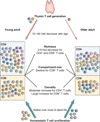Naive T cell maintenance and function in human aging
- PMID: 25888703
- PMCID: PMC4452284
- DOI: 10.4049/jimmunol.1500046
Naive T cell maintenance and function in human aging
Abstract
In studies of immune aging, naive T cells frequently take center stage. Describing the complexity of the human naive T cell repertoire remains a daunting task; however, emerging data suggest that homeostatic mechanisms are robust enough to maintain a large and diverse CD4 T cell repertoire with age. Compartment shrinkage and clonal expansions are challenges for naive CD8 T cells. In addition to population aspects, identification of potentially targetable cellular defects is receiving renewed interest. The last decade has seen remarkable progress in identifying genetic and biochemical pathways that are pertinent for aging in general and that are instructive to understand naive T cell dysfunction. One hallmark sets naive T cell aging apart from most other tissues except stem cells: they initiate but do not complete differentiation programs toward memory cells. Maintaining quiescence and avoiding differentiation may be the ultimate challenge to maintain the functions unique for naive T cells.
Copyright © 2015 by The American Association of Immunologists, Inc.
Figures

References
-
- Thompson WW, Shay DK, Weintraub E, Brammer L, Cox N, Anderson LJ, Fukuda K. Mortality associated with influenza and respiratory syncytial virus in the United States. JAMA. 2003;289:179–186. - PubMed
-
- Levin MJ. Immune senescence and vaccines to prevent herpes zoster in older persons. Curr Opin Immunol. 2012;24:494–500. - PubMed
-
- Fulop T, Larbi A, Kotb R, de Angelis F, Pawelec G. Aging, immunity, and cancer. Discov Med. 2011;11:537–550. - PubMed
Publication types
MeSH terms
Grants and funding
LinkOut - more resources
Full Text Sources
Other Literature Sources
Medical
Research Materials

